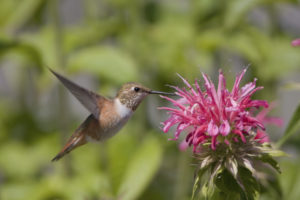
Traveling approximately 23 miles per day, all the way from Central America to Minnesota, hummingbirds can work up quite an appetite! They can fly at a speed of about 30 miles an hour, and up to 60 mph when diving. They can slow down from full speed to a dead stop in a space of just a few inches. The hummingbird is the only bird that can truly hover. It manages this by flapping its wings 20 to 80 times a second. It can fly straight up and down, backwards and forwards, or upside down. Amazing!
Did you know that hummingbirds must eat once every 10 to 15 minutes? They visit between 1,000 and 2,000 flowers per day! Planting hummingbird-friendly plants is very helpful to them and can provide great entertainment for you too! Red is their favorite color and some of their favorite flowers include daylily, penstemon, monarda, peony, tall garden phlox, hibiscus, honeysuckle, coneflower and weigela! Growing native plants also tends to provide much more nectar than hybrids and exotics do.
Hanging hummingbird feeders in your yard is also very beneficial to them. Be sure to place your feeders far enough apart that the hummingbirds cannot see one another, which will prevent one bird from dominating the rest.
Hang your feeders in the shade to prevent the sugar solution from fermenting, and be sure to change the sugar water regularly. The warmer the weather, the more often you must refresh it. With our temps here in Minnesota, that would generally be every 3 to 6 days. Also be sure to clean the feeders with a solution of one-part white vinegar to four-parts water about once a week.
Nectar:
- 1/4 cup refined white sugar (Please do use refined white sugar. Honey can promote dangerous fungal growth, and organic, natural, and raw sugars contain levels of iron that could be harmful.)
- 1 cup boiling water
- Bowl
- Spoon
Note: Red coloring is not necessary and the chemicals could prove to be harmful to the birds.
(sources Audubon.org, Hummingbirdpots.com)
